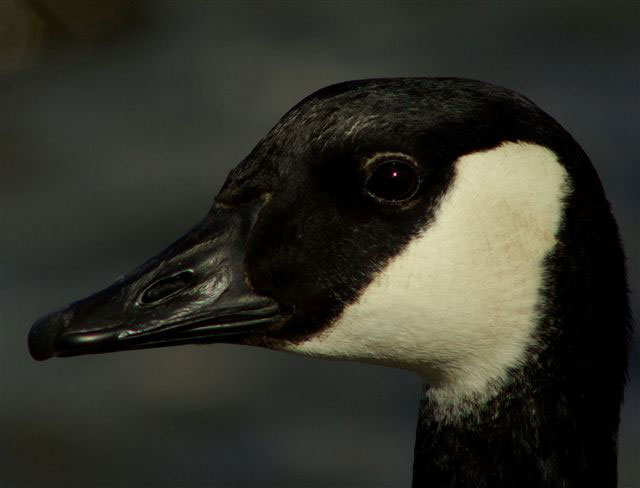
Canada Goose:. This bird is part of the feral flock at Rother Valley Country Park in South Yorkshire. Standing out from the other 'canadensis' types this has 'extra' white over the cheeks extending further down the neck. It also has a faint line of white feathering across the forehead. Compared with other Canadas it is the largest in the group and is paler both above and below. These are characters of the Giant Canada Goose or Giant Prairie Goose, which was considered to be extinct until the 1960s. The man who rediscovered the Giant Canada Goose has dropped a bombshell on the world of Canada Goose taxonomy and identification, with his posthumously published two-volume work (photo: Martin Garner).
Introduction
For anyone who has taken a family walk around a park lake well stocked with large Canada Geese and discovered the joys of shoes and child's buggy bedecked in green slimy goose-poo, that these 'honkers' struggle to inspire interest among the British birding public is hardly surprising.
However, in North America, of course, they really are 'wild geese' with many undertaking phenomenal migrations, breeding in hostile environments and eluding our best attempts to understand their variety and complexity. Indeed the Canada Goose may represent THE BIRD (when considered as just one species) that demonstrates the single greatest level of variation of any bird species in the world. The Giant Canada is the largest form of goose in the world and the little minima, Cackling Canada, is one of the smallest. Wild Canada Geese occur every year in this country as vagrants, and yet their specific origins and identification remain a mystery that is only very slowly beginning to be resolved and understood...with many wrong assumptions and blind alleys regularly stymieing our progress. For those who like to be involved in 'discovery' in their birdwatching, there is perhaps no greater challenge than the taxonomy and identification of vagrant Canada Geese in the UK today.
The Present Situation
The taxonomic decision-making bodies in North America (the AOU) and the UK (BOURC) recently split the Canada Goose complex (hereafter White-cheeked Geese) into two species. The split simply divided the 11 familiar, and most frequently assigned, subspecies into large and small-bodied birds as follows:
Greater Canada Goose (Branta canadensis) with subspecies
- canadensis (Atlantic)
- interior (Interior or Todd's)
- maxima (Giant)
- moffitti (Moffit's)
- parvipes ('Lesser')
- fulva (Vancouver)
- occidentalis (Dusky)
Cackling Goose or 'Lesser Canada Goose' (Branta hutchinsii) with subspecies
- hutchinsii (Richardson's)
- leucopareia (Aleutian)
- taverneri (Taverner's)
- minima ('Cackling')
The limits of this arrangement were immediately obvious to those familiar with the subject. For example, in terms of nomenclature, what is familiarly known as the Lesser Canada Goose (ssp. parvipes) is now a Greater Canada Goose though some individuals are reportedly indistinguishable from ssp. taverneri, which is now a Lesser Canada Goose! Hmmmmmm...
The identification of vagrants to the UK seems to become more of a conundrum with each winter's new arrivals. When using the framework of these 11 subspecies then in many cases the vagrants simply do not fit the described 'classic' appearance of these forms and the vagrancy potential of some forms that it is suggested occur here, based on the available literature (such as parvipes and taverneri), are not really likely candidates for vagrancy to Western Europe. So what is going on?
An Overview of White-cheeked Geese
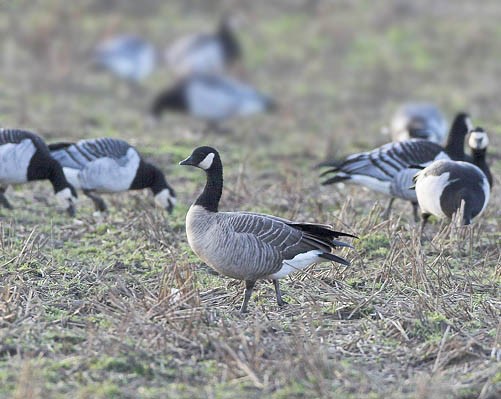
Unidentified White-cheeked Goose: Caerlaverock WWT, Dumfries and Galloway This bird is hard to place! It is a little longer-bodied in real life than Barnacle Goose with a proportionately longer neck and legs and the overall structure suggests a small intermediate Canada. However it shows the real dilemmas sometimes faced as it has such a conical bill, and in height the bird, at times, looks even smaller than the Barnacles. Is it an Arctic Goose or small intermediate Canada Goose? It is very likely NOT to be a Taverner's Goose as has been widely reported. With some birds it will take time before some of these issues are resolved. But the exciting thing is that much is yet to be discovered (Photo: John Anderson)
As well as being the most varied in appearance, White-cheeked Geese are the most widely distributed geese in North America. Broadly speaking the larger-bodied birds are found mostly in interior North America in the southern part of the breeding ranges and have the shortest migration distances. As you progress northwards towards the harsher arctic climates the birds become smaller and these are the populations that migrate the greater distances.
It is very important to be aware of some aspects of their behaviour. White-cheeked Geese typically breed alone or in small, localised, colonies. They pair for life and most young (particularly females) return to breed in the same place that they hatched. They also have specific population flyways, stopping to refuel (staging), and wintering, faithfully at the same location year upon year. Occasionally environmental factors cause them to change wintering locations, in which case the whole of the population is involved. These basic understandings are important because it is not difficult to see that reported widespread intergrading between two populations is actually going to be pretty unlikely if they pair for life and go back to their natal site to breed, as well as 'hanging-out' with their 'kin' all year round, even though most do mix with a variety of other forms on the wintering grounds. The taxonomy of most Holarctic species of geese has similarly suffered the fictitious spectre of 'widespread intergradation' based nearly always on unproven supposition.
The problem of too little data
With some fluctuations, the taxonomy of White-cheeked Geese over the 20th century resulted variously in 8 to 12 subspecies being recognized, and from one to four different species, across their vast range and seemingly infinite variety.
The core problem that has beleaguered the taxonomy of the White-cheeked Geese is the poverty of data. For example, John Aldrich, who reviewed the taxonomy in 1946, used 359 specimens, of which only 28 were from the breeding grounds, and with these cemented our contemporary understanding of the 11 subspecies. All subsequent taxonomic arrangements, as far as I am aware, have been built on the same limited data, thus repeating the same assumptions and arguably perpetuating a poor overview of the true situation. With such a vast range, tremendous variety and inaccessibility of large areas of northern breeding grounds, perhaps we should not be surprised that taxonomic arrangements thus far seem to have failed fully to address that which seems to be actually observable in the field.
Enter Harold Hanson
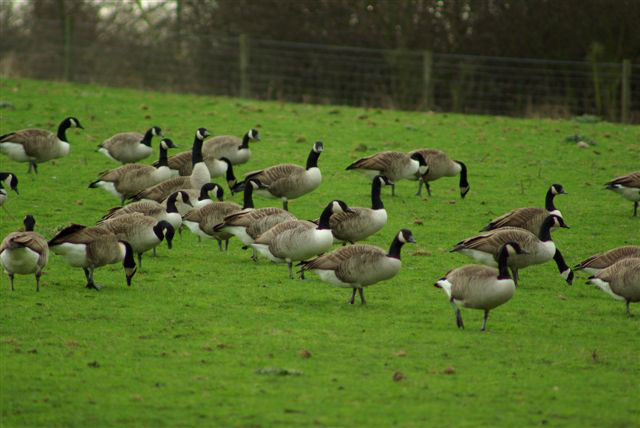
Giant Prairie Goose: Canada Goose showing characters of the Giant Prairie Goose Branta maxima, which was once thought to be extinct, and was separated by Hanson as a full species. Occasionally birds showing such characters may be found amongst the UK feral stock (photo: Martin Garner).
Harold Hanson's lifetime's work on the Canada Geese (The White-Cheeked Geese: Taxonomy, Ecophysiographic Relationships, Biogeography, and Evolutionary Considerations, published by Avvar Books) is unequivocally monumental in its scope and in its conclusions. It already has its plaudits and critics alike, both of whom are left secretly trying to fathom whether Hanson's work really does usher in a whole new understanding of these wild geese. Volume 1, of a two-part work, published last year, is perhaps of greatest interest to observers in the Western Palaearctic as it covers the eastern taxa, i.e. those most likely to occur on this side of the Atlantic. Hanson died in 2003 having spent 50 years of his life working on this project. He concluded that the White-cheeked Geese can be divided into six different species (not two) and in Volume 1, 78 new subspecies of canadensis and 84 new subspecies of hutchinsii are presented. That's just for starters!
Hanson's taxonomy
Six Species of White-cheeked Geese
- Canada Goose Branta canadensis
- Giant Prairie Goose Branta maxima
- Ontario Goose Branta "lawrensis"
- Arctic Goose Branta hutchinsii
- Aleutian Goose Branta leucopareia
- Cackling Goose Branta minima
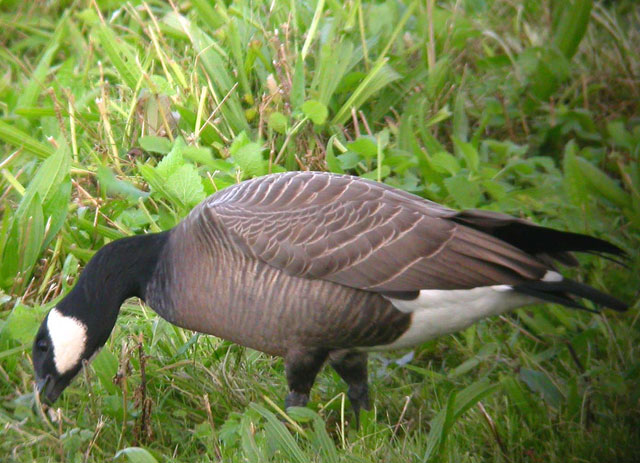
Cackling Goose: Norfolk (in captivity) This is one of the smallest geese is the world and is treated as a separate species by Hanson. Commonly kept in captivity in the UK, it is an unlikely vagrant. It has a very distinctive 'burnt bronze' or purplish (depending on the light) sheen to various parts of plumage with darkening especially on the breast. It seems, however, that a number of birds previously considered to be 'minima' may in fact have been small dark Arctic Geese that are genuine vagrants. Hitherto a lack of knowledge and the '11 forms only' approach has stifled attempts at identification (Photo: Martin Garner)
With such radical conclusions it is important to assess his credibility. Hanson is most well known for the rediscovery of the Giant Canada Goose ('maxima'), which was considered extinct for most of the latter part of the 20th century. It is a touch ironic that 'maxima' has never been recognised by the AOU over the 40-year period that it was championed by Hanson until this recent, arguably already out-of-date, two-way species split, published one year after his death! In comparison to Aldrich's 359 specimens (8% from breeding grounds), Hanson used 1,800 specimens, 60% of which had come from the breeding grounds. Although there is some strong criticism and questioning of Hanson's conclusions around, his dataset is surely second to none, and sets a much higher bar for a minimum level of data required to make genuinely informed comment on White-cheeked Goose identification and taxonomy.
In layman's terms, his basic understanding was that it is environment that affects the microevolution of each local population of geese. Thus Hanson, broadly speaking, makes the case that each local population in slightly different environments forms a different subspecies. Their breeding, and wintering, behaviour causes each population to be essentially reproductively isolated from other populations.
In terms of the White-cheeked Geese that we get in the UK, this actually provides us with a much better platform to begin trying to identify individual birds or at least understand some of the variety we encounter. Hanson identifies birds in the North Hudson Bay/Baffin Island and Ungava areas of northeast Canada that seem to fit the appearance of the variety of vagrant Canada Geese that we are seeing here considerably better then the '11 only' subspecies approach.
For example, consider the riddle of the darker breasted hutchinsii seen in the UK. The provenance of such birds as 'good' hutchinsii has been repeatedly questioned. This is because the description of classic hutchinsii is of a silver-breasted bird. However this is based on a specimen from the western Canadian high Arctic. Hanson ably demonstrates that there really are darker-breasted populations that are consistent in appearance, and look exactly like some of the bird we get here, as well as paler-breasted populations that nest nearby. Hanson's dark-breasted "Fox Basin Arctic Geese, ssp. baffinensis" from southern Baffin Island fits some of our birds very nicely!
Much of Hanson's conclusions are well tested, while others are unproven hypotheses based on positive results elsewhere. It is argued that not all of his scientific approach incorporates the latest understanding and techniques. Nevertheless I believe this book will require of us a Herculean change in the way we look at Canada Geese, and cannot be lightly dismissed, as frightening as it may seem. Indeed I believe it will become the sine qua non for future research, identification, taxonomy, and crucially, conservation of the White-cheeked Geese, even if only some of his conclusions are fully validated. With that view in mind here is a preliminary 'new approach' to the way we could be heading with identifying vagrant Canada Geese.
In terms of vagrants to Britain that would be classified as species, we need only concern ourselves with the Arctic Goose (a much-preferred name to Lesser Canada) and the vagrant Canada Goose (of various medium-sized and larger forms or subspecies).
Birders do come across Cackling Canadas and birds showing characters of the Giant Prairie Goose in the UK, but for the time being these are most likely to be considered as introduced/escaped birds.
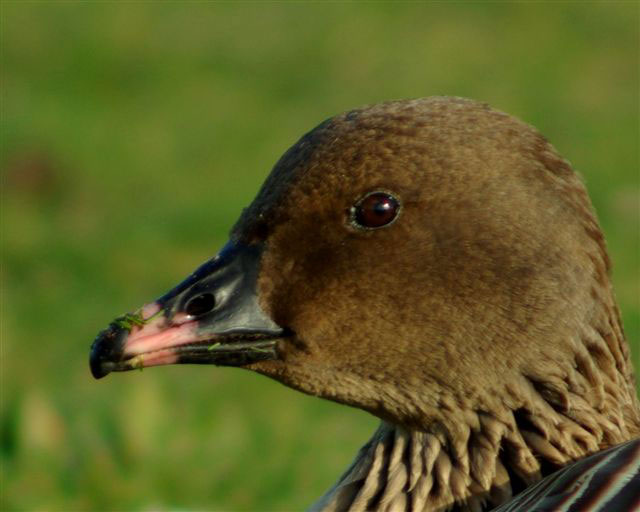
Pink-footed Goose: Pink-footed Geese that breed in Greenland are one of the main 'carrier' species of vagrant Canada and Arctic Geese. They also provide an excellent size comparison in deciding which 'type' of vagrant Canada or Arctic Goose is involved (photo: Martin Garner).
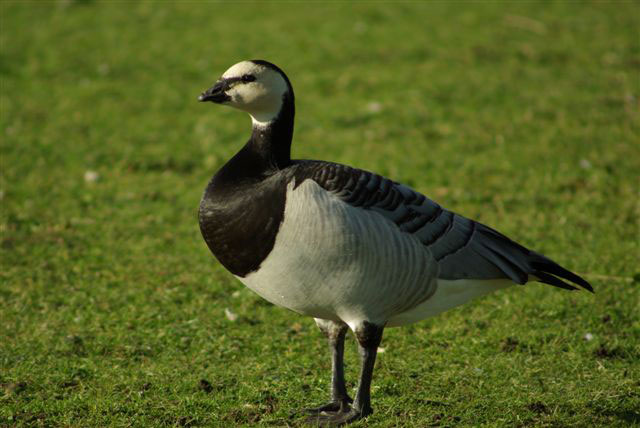
Barnacle Goose: This is a feral bird, but the thousands of Barnacle Geese, especially those form the Greenland breeding populations, wintering here are another main carrier species (photo: Martin Garner).
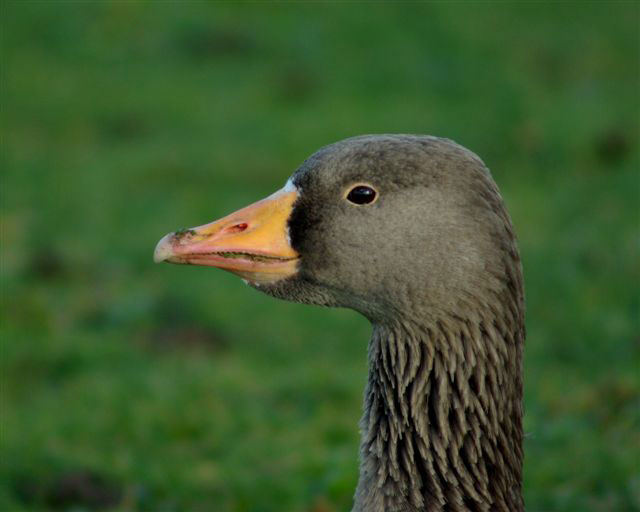
Greylag Goose: Another Canada and Arctic Goose carrier...the trusty Greylag. Any Canada Goose as large as, or larger than, Greylag would fall into the canadensis/interior category (per Hanson) with the latter being the more likely vagrant (photo: Martin Garner).
Suggested Identification Process using Hanson
Step 1: confirm the bird is a White-cheeked Goose and not hybrid!
Step 2: careful size assessment compared with other geese using the following categories:
Large Canada Geese
The bird is obviously larger than Pink-footed Geese/Greenland White-fronted Geese and may appear the same size as, or even larger than, Greylag Geese.
In my view, this narrows the choice generally down to two subspecies of Canada Geese that are likely to be seen using Hanson: 'canadensis' and 'interior'. Of these, canadensis is a shorter-distance migrant with a flyway along the eastern seaboard that does not suggest it will be as likely a vagrant. Hanson's strict use of interior is also of a large Canada Goose, being a tad darker than canadensis with a tendency for darker buffy fringes to the upperparts. There are some individuals with interior-like characters in the feral UK population. However it is highly likely to occur as a vagrant as well...but is (in Hanson's strict sense) a LARGE goose.
Intermediate Canada Geese
This is clearly the hardest group to assess, due to subtle size difference and a range of sizes between smaller intermediates and larger intermediates. Pink-footed Goose is a good rough guide as to what is meant by intermediate-sized Canada Geese, with some slightly larger and some slightly smaller. They are distinguished from the Arctic Geese usually (but not always) by obviously longer, shallower/thinner-looking bills. They also have longer-looking bodies and longer legs.
Here was the area that I found Hanson to be most enlightening. He presents a variety of intermediate-sized Canada Geese breeding in the sub-arctic zones of Baffin Island and northern Hudson Bay. Their field characters include: variously darker-flecked to unmarked white cheeks; variously darker- and paler-plumaged populations; varying degrees of dark throat bars; and pale neck rings.
A number of these types seem to easily fit the appearance of birds that have been incorrectly assumed to be taverneri and parvipes in the UK. However the breeding range and migration strategy of Hanson's 'intermediate' Canada Geese makes them much more likely as vagrants than the western forms. I am not sure whether we will ever be able to assign every vagrant seen in the UK to a specific population but in the coming winters we can at least have on our radar that there are a number of plumage types among these intermediate Canada Geese which correctly, or incorrectly, Hanson subspecifically labelled, such as:
- the darker-cheeked hunti
- the slightly paler suttoni
- the shorter-billed charcoti
- the paler-breasted soperi and davisi
Arctic Geese
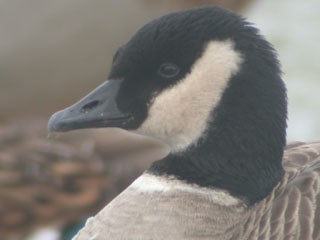
Arctic Goose: Caerlaverock WWT, Dumfries and Galloway This was one of two birds that apparently arrived with the Barnacles and eventually found the other (feral) White-cheeked Geese (canadensis) on the Peter Scott pond, thus demonstrating the unreliability of assuming that everything that looks feral is so! These were both Barnacle-sized geese of dumpy proportions and can easily be called 'Arctic Geese'. Exactly which population from northeast Canada they have come is less clear. As we record the plumages, bill shapes and occurrence patterns the situation may well become clearer (Photo: Allan Sumner)
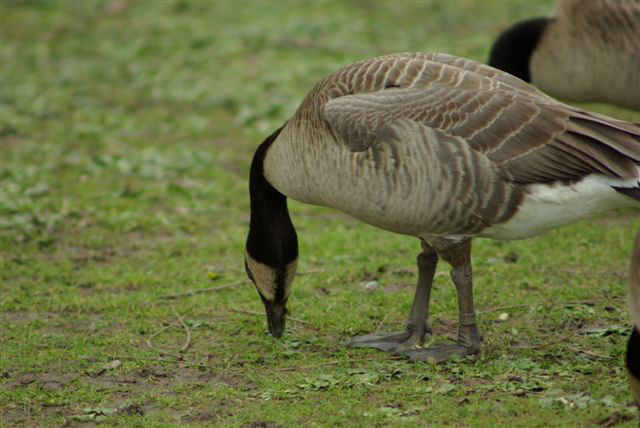
Arctic Goose : This Arctic Goose is part of the 'hutchinsii' stock at Slimbridge WWT. The slight difficulty with captive birds is unknown origins and potential of inbreeding over the years with other captive stock. Nevertheless it is interesting to note these rather typical hutchinsii also have a tendency to have a dark throat bar. The dark throat bar would seem to be a feature also of some north eastern populations in Canada and therefore it is no longer a starting point to refer to birds with this character as Taverner's. Taverner's is, in reality, a rather unlikely vagrant (photo: Martin Garner).
Barnacle Goose is the most useful standard. Arctic Geese are around the size of Barnacle Geese, some being slightly bigger and others slightly smaller. They are noticeably compact in shape, with short and rather triangular-looking bills, and are rather short-legged. Hanson demonstrates there is considerable variety in the appearance of Arctic Geese that could reach the UK, including plainer dark-breasted birds (e.g. 'frobisheri', which could recall minima), birds with dark breasts and pale neck rings (e.g. 'baffinensis') as well as the classic silver-grey breasted bird (e.g. 'kumlieni'). This goes a long way to explaining some of the perplexing variety of 'hutchinsii' we have been encountering in the UK. It is not unusual for Arctic Geese to have dark throat bars.
In the early stages of gaining a 'corporate consciousness' of the types of vagrant White-cheeked Geese we get in the UK, it may even be a struggle, in some cases, to distinguish whether an individual falls into the Canada Goose or Arctic Goose category due to the smaller size of some Canada Geese (using Hanson).
It is also clear from Hanson that much more detailed information should be gathered that may help us to discover if there are particular sub-populations that turn up regularly as vagrants. These details include:
- Upperpart plumage (described in detail relative to other areas of plumage).
- Underpart plumage (described in detail relative to other areas of plumage).
- Degree of dark throat line.
- Presence/absence of dusky tips on white cheeks.
- Degree of presence (front and back) of pale/white collar at base of neck sock.
- Bill shape.
Great care should be taken to describe as accurately as possible all plumage and structural details of any given individual, whose circumstances suggest it could be a wild vagrant White-cheeked Goose.
Learning to Describe White-cheeked Geese (all over again)
What I would argue is that Hanson has initiated a need for us to learn to look at, and describe, these geese as if we knew nothing. We need to take one step back. Instead of rushing to try and put subspecific names on individuals, we need first to LEARN to watch, and describe, the characters of an individual bird. What should we be looking for?
Certain 'types' (potentially labelled as type A, B, C, D, etc.) will become evident. We can then record the occurrence pattern of these types and slowly build up a picture of what is really happening.
Here is a good example of a vagrant White-cheeked Goose description from Roger Riddington of a bird in Shetland. Rather than trying quickly to name the bird to subspecies, he has carefully noted its structure and apparent size (which varies considerably with posture) in relation to the accompanying geese (both Greylags and Barnacles). Various aspects of its plumage are described in some detail and a significant effort has gone into describing the bill structure and size.
At this early stage it might best be described as fitting a 'small intermediate' Canada Goose rather than an Arctic Goose. It could be called, for example, 'type 1' and an effort has been made to record the frequency/distribution and carrier species of this particular type of White-cheeked Goose in the UK over successive winters.
Scatness, 6th November 2004
Canada Goose 1. Found by Steve Minton, and clearly an individual of one of the smaller races (though by no means tiny). Roughly 80% of the size of the accompanying Greylags; subjectively it seemed quite long-legged. Overall quite dark, with rather grubby white chinstrap, clearly divided by a rather thick, blackish, messy gular line. Breast and flanks quite boldly/markedly scalloped with white. Black neck 'sock' sharply demarcated at the front, longer at rear, where it merged diffusely with the brownish mantle.
Loch of Spiggie, 14th November 2004
Small Canada Goose still present amongst the Barnacle Goose flock. The Canada was only slightly larger than the Barnacles (roughly <5% smaller); but overall sleeker and less stocky than the Barnies. The head shape seemed rather square to me - certainly square rather than rounded. Again it looked rather long-legged. Chinstrap dusky/dirty white - not clean and striking like the white face of a Barnacle. Uniformly dark brownish breast and flanks - not as shown in the photos, where the breast appears slightly 'bleached-out'.
Loch of Spiggie, 12th December 2004
The same party of Barnacles plus Canada Goose as seen yesterday, still present at Littleness.
Good views of the small Canada Goose yesterday and again today, and some pictures taken today. I spent a lot of time looking at its bill in comparison with the Barnacles, and the best comparison I could come up with was that the culmen was closer to one-and-a-third than one-and-a-half the length of an average Barnacle Goose. Taking the figures in BWP (with an 'average' Barnacle having a bill length of 30 mm), this would put the bill length closer to 40 mm than 45 mm. Although it's difficult to justify millimetric precision in field views, this suggests that the bill is below the range given for interior, and bang on for parvipes. In terms of body size, compared with Barnacle, it varied according to posture, appearing anything from 0 to 10+% bigger than Barnacle, though consistently longer- and slimmer-bodied, longer-legged. Even though it generally looked slightly bigger, you could imagine that the weight of the more compact Barnacle would still match it.
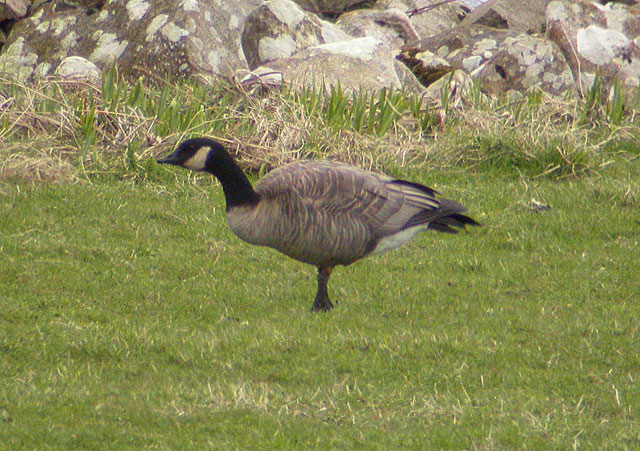
White-cheeked Goose: (photo: Roger Riddington).
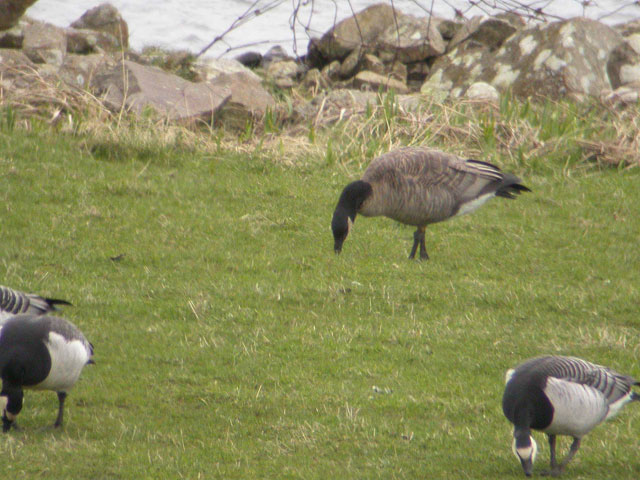
White-cheeked Goose : (photo: Roger Riddington).
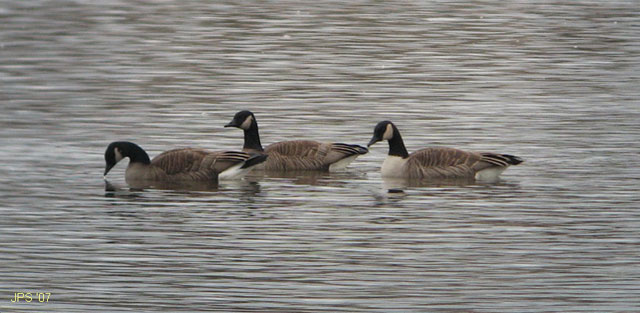
Canada Geese of different forms: Three White-cheeked Geese from Massachusetts taken by James Smith. They are clearly larger birds with rather long bills, though sitting relaxed on the water causes their necks to be retracted and appear rather short. Here are James's comments on his photo. "interior is assumed to refer to the wide application ('11 only' subspecies) rather than Hanson's narrow definition." My interpretation of the attached is of two dusky breasted interiors from the same brood showing similar aberration at the rear edge of the cheek patch, plus one pretty normal canadensis." (photo: James Smith).
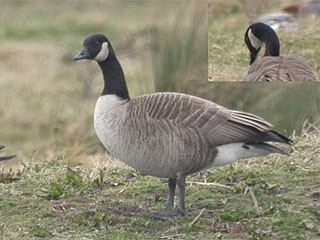
Canada Goose: Bolden Flats NR, Durham If you only have the '11 subspecies system' to go on, then this seems to fit the unlikely vagrant 'parvipes'. In terms of plumage it looks rather like a shrunk-down canadensis and using Hanson such populations of White-cheeked Geese do exist in northeast Canada. For the time being it is probably best to describe this as an Intermediate Canada Goose of type X. However, as we resolve our attempts to classify these birds we should not lose the wonder of migration, vagrancy, and infinite variety that is synonymous with the White-cheeked Geese! (Photo: Mark Newsome)
Acknowledgements
I readily acknowledge the pioneering work of Chris Batty, Tom Lowe, Paul Hackett, Chris Kehoe and Richard Millington from a UK perspective . They have in endeavored, quite rightly, to keep these fascinating birds in the public arena. RM woke many of us up to 'Hanson'. Jimmy Steele too has championed the cause of these birds and I wish to thank James Smith and John Martin for discussion and all the photographers involved here.
References
Hanson, Harold C. 2006. The White-Cheeked Geese: Taxonomy, Ecophysiographic Relationships, Biogeography, and Evolutionary Considerations, Volume 1. AVVAR Books, Blythe, California.


